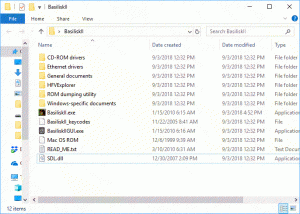

- #Basilisk ii settings retropie serial
- #Basilisk ii settings retropie archive
- #Basilisk ii settings retropie android
- #Basilisk ii settings retropie software
- #Basilisk ii settings retropie mac
To getuninterrupted output for the emulation of built in sound,there is a buffer that the operating system can get samplesfrom, even if Mini vMac doesn’t get time for a while.(This buffering results in lag, which can be a problem such as forgames, so Mini vMac dynamically tries to figure out just how muchbuffering is needed.) But this is probably not the main issueyou are seeing. The operatingsystem will give Mini vMac time to run when it feels like it. I can think of two reasons for such jitter.First, OS X is not a real time operating system.
#Basilisk ii settings retropie serial
i can easily add a tcpsocket to pass raw serial byte streams between mini vmac and the hostos. when you have a moment, please see this analysis docfor further info:Ī fellow Mini vMac user also suggested at the forum that serial io mightbe beneficial for other scenarios beyond midi. however, there's some jitter that i'd like to get rid of, and washoping if you could point me into the right direction on where toaddress the issue. The emulation works really well: no stuck notes and sysex works bothways. a link to an experimental build anddiscussion is at the parser also provides a bridgeto/from the host OS midi ports. it hooks into sccemdev.cto forward the serial bytes into a midi packet parsing routine thatresides in a separate source file. I've implemented a midi bridge for Mini vMac. The Text Based Variations Serviceallows you to directly type in options like“-hres” and “-vres”. The Mini vMac 36 Variations Servicemakes it easy to try out compile time options, compiling customversions of Mini vMac in a few seconds.


But the main emphasis in Mini vMac is compile time options,which allows Mini vMac to be smaller and simpler. “-hres” and “-vres” are not commandline options, they are options to the Mini vMac build system.The few supported command line options are documented in the Mini vMac User Interfacepage.
#Basilisk ii settings retropie software
People that are new to Mini vMac don’t necessarilyneed to deal with the import issue much at first, sinceI provide lots of software already imported into disk image formaton my Macintosh Plus software page. These hooksdon’t exist in the earliest versions of Macintosh OS.Third, host drive access seems the kind of thing that could mostlywork, but frequently run into edge case issues that people wouldcomplain to me about, taking up a lot of my time. Second, if I recall correctly, Basilisk II useshooks for external file systems in the Macintosh OS. First,it would require a lot more platform specific code, making Mini vMacharder to port. I wouldn’t completely rule out ever adding a host drive accessfeature to Mini vMac, but I don’t have much enthusiasm. Each can run some software that the other can’t.
#Basilisk ii settings retropie mac
Mini vMac has more emphasis on emulating the earliestMacs, while Basilisk II has more emphasis on later Mac 68ksoftware. If you prefer to access host drives in Basilisk II, it makessense to do that, and use the disk images you create there inMini vMac. Most archivefile formats are safe to move between Windows and Mac.) (If you are not dealing with plain text,then you have to deal with the issue of files moved to Windows losingMacintosh specific information like resource forks. If you are just dealing with plain text, the utilities ClipIn and ClipOutmay be more convenient.
#Basilisk ii settings retropie archive
If you have lots of files you want to import, it may be easierto create an archive of them first on Windows (in some formatthat old Macs can deal with), import the archive, and thenextract the archive inside Mini vMac. Mini vMac really really needs the ability to access host drives likebasilisk II can, I had to quit using it after 15 minutes because of howtedious it is to pack hfv disks with hfv explorer just to satisfy minivmac, the emulator is all but cut off from the outside world in it'scurrent rendition.Īlso i found that mini vmac did not recognize any of the command lineswitches you have in your documentation (like -hres and -vres).īesides HFVExplorer for Windows, my utilities ImportFl and ExportFlcan be used to get files into and out of Mini vMac disk images.(HFVExplorer is old and unmaintained, so I have doubts about howwell it will continue to work in the future.) (Note that I am not involved with this port.)
#Basilisk ii settings retropie android
I would like to know if I can get Windows on my android phone?ĭo you mean running Microsoft Windows on Android? That isout of the scope of Mini vMac.īut Mini vMac, which runs versions of Classic Mac OSthat had windows before Microsoft Windows existed, has been portedto Android.


 0 kommentar(er)
0 kommentar(er)
